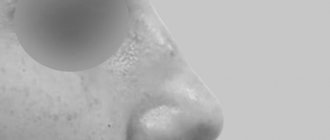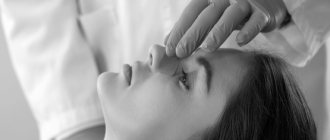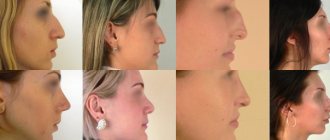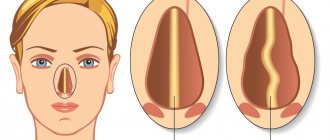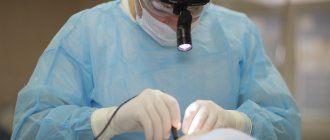If you decide to undergo rhinoplasty, the question of anesthesia immediately arises. This is one of the key points that worries the patient. It is impossible to definitively answer the question of what kind of anesthesia is needed for rhinoplasty. The choice is influenced by the individual characteristics of the patient, the method of surgical intervention, and the complexity of the correction itself.
In this article we will try to familiarize you with all types of pain relief as clearly as possible. Let's look at their advantages and disadvantages in nose correction.
Only your attending physician can choose the method of anesthesia during surgery, taking into account all the specifics of your case.
Rhinoplasty of the nose under local anesthesia
Many people are concerned about whether rhinoplasty is performed under local anesthesia. In this case, it is worth seriously weighing the pros and cons. In most cases, rhinoplasty under local anesthesia is performed for a simple nose correction. This type of anesthesia is also used when general anesthesia is contraindicated for some reason.
Most often, tip rhinoplasty is performed under local anesthesia. This method is also used if the operation is aimed at removing a hump. In more complex cases, surgeons prefer general anesthesia. Infiltration anesthesia is used, in which the nasal tissues are impregnated with an analgesic. The mechanism of operation of this anesthesia is to block impulses that are responsible for pain at the injection site. At this time, tactile and temperature sensitivity are preserved. For this type of anesthesia, the following drugs are used: Lidocaine, Marcaine and Xylocaine. Please note that before using any of these products, you need to do an allergic reaction test.
In some cases, the use of such anesthesia is prohibited:
- psychomotor agitation;
- individual intolerance to local drugs;
- mental disorders;
- problems with the respiratory system
Sometimes the patient himself is categorically against the use of local anesthesia, because rhinoplasty is a facial operation, and looking at the surgeon during the operation is a severe blow to the psyche. Local anesthesia is always a risk for the patient and the doctor. After all, there is no one hundred percent guarantee that even the calmest person will not move during the operation, and this is fraught with consequences. Therefore, to be on the safe side during rhinoplasty, some kind of sedative is traditionally administered under local anesthesia.
How is anesthesia administered?
There are several types of painkillers, differing in the form of the condition, purpose and mode of action:
- solutions for intravenous administration that have a hypnotic or analgesic effect (or both);
- gases for inhalation, also combining two effects;
- drugs for muscle relaxation.
The Osnova plastic surgery clinic uses a modern approach to anesthesiology, in particular multicomponent. This means that during the operation, not one, but several types of drugs are used at once, each of which is responsible for a separate function. Some provide pain relief, others have a hypnotic effect, and others promote muscle relaxation.
During work we use inhalation anesthesia. The drugs enter the patient's body through a laryngeal mask connected to a ventilator or an endotracheal tube. The operation does not begin until the patient falls asleep. Throughout the entire intervention, the anesthesiologist monitors the condition of the patient’s body using a large number of sensors connected to the patient. The optimal concentration of drugs is maintained throughout the operation. After finishing the work, the surgeon gives the command to the anesthesiologist to stop the anesthesia. From this moment, the concentration of drugs begins to slowly decrease, and a short time after the operation, the patient wakes up and is sent to the intensive care ward under the supervision of medical workers.
Within 20 minutes after the end of the manipulations, the patient will be fully conscious and clear-minded, will be able to talk with his loved ones and will feel great. Our anesthesiologists are highly qualified specialists who ensure complete safety and comfort for our patients.
Rhinoplasty under general anesthesia
If a major operation is planned to correct nasal defects, or several corrections will be made at once, it is preferable to choose general anesthesia. There are two ways to perform this anesthesia:
- Anesthesia through a mask, for rhinoplasty - endotracheal.
- Intravenous administration of the drug.
Your doctor will help you choose the method of pain relief; the preparation in both cases is similar.
How to prepare for anesthesia
General anesthesia is the introduction of the patient into a state of deep sleep, during which sensitivity and consciousness are completely lost. Before undergoing anesthesia, you should definitely consult an anesthesiologist in order to avoid possible negative consequences and feel good after recovery from anesthesia. It is very important to follow the diet and premedication, which we will discuss below.
What is premedication
In most cases, the process of administering anesthesia frightens the patient even more than the operation itself. Therefore, doctors recommend taking sleeping pills, antihistamines, and tranquilizers the night before surgery. All these drugs must be selected by the attending physician and taken in the dosage prescribed by him. The essence of this preparation is not only the patient’s peace of mind, but also a decrease in the secretory function of the biological fluid of the body’s glands. In the case of rhinoplasty, this plays a big role.
Diet before surgery
Just a couple of decades ago, before surgery, the patient could not eat solid food for 18-12 hours. Today, doctors have come to the conclusion that this prohibition has been reduced to 6 hours, and coffee and tea can only be drunk 2-3 hours before surgery. Such recommendations are a necessary measure to avoid the reflux of stomach contents into the lungs. During general anesthesia, all muscles are completely relaxed, and the intestinal, gastric and esophageal sphincters do not work enough. The worst complication of general anesthesia is pneumonia. The condition may occur due to damage to lung tissue by acidic stomach contents. This can be fatal.
Administration of anesthesia intravenously
With this type of anesthesia, the patient is given narcotic drugs that help turn off the centers of the brain responsible for the perception of pain. In order to correctly calculate the required dose, it is imperative to know the patient’s weight. The main advantage of this method is the rapid induction of anesthesia, but the disadvantage is the short duration of action of the drug. For such anesthesia, the drugs most often used are: Thiopental, Viadryl, Sodium Oxybutyrate, Xenal.
Indications for nose tip correction
- wide tip of the nose;
- asymmetrical tip of the nose;
- “dangling” tip of the nose;
- excessively upturned tip of the nose;
- tip with a pronounced columella.
“My approach to modeling is this. I photograph the patient from several angles, print the photo in black and white, take a sharpened pencil, and the patient and I begin to plan the future nose together. Right in the photo we are “working” with our noses, and together we come to all decisions. Yes, a photo taken in the editor can be quite visual. But, in my experience, on a piece of paper the patient more accurately formulates his tasks, becomes a “participant” in the operation, and we successfully work in tandem. This means that the result will be excellent, because we will take into account all the nuances, even the smallest ones.”
Tamarov Alexey Nikolaevich plastic surgeon
Types of rhinoplasty for nose tip correction
Potato nose
The problem with this nose shape is that the lower lateral cartilages are located at a considerable distance from each other. The specialist stitches the cartilage together using cartilage autografts. Rhinoplasty to narrow the tip of the nose makes the nose neat and harmonious.
A long nose
To make the nose visually shorter and “raise” the tip of the nose, the specialist makes incisions on the legs of the wing cartilages, this has the effect of “weakening” the structure that supports the tip of the nose. This procedure in professional language is called “transfixation incisions.” During the operation, the nostrils widen and the nose does not look so long.
Short nose
The surgeon connects the central legs of the lateral cartilages and installs a spacer of cartilage autografts between the cartilages. As a result, the nose becomes graceful and beautiful.
Snub nose
The legs of the lower lateral cartilages are sutured, the principle of their connection with the septum is changed, and the lateral cartilages are truncated. After a successful operation, the nose becomes smooth and neat.
Cost of rhinoplasty
| Name | Price |
| Plastic surgery of the tip of the nose | 130,000 rub. |
| Revision rhinoplasty | from 200,000 rub. |
| Primary appointment (examination, consultation) with a plastic surgeon | FOR FREE |
Example of nasal tip plastic surgery
Endotracheal anesthesia
This anesthesia is a type of general anesthesia. This method of pain relief includes the following steps:
- The patient is given anesthesia intravenously;
- Tracheal intubation
Actually, the goal of the first stage is to completely relax the patient before the second stage. Intubation is the insertion of a special probe through which an anesthetic will be injected, and artificial ventilation of the lungs is also performed. The procedure is not pleasant, so you cannot do without a preliminary intravenous injection.
What are the advantages of this type of anesthesia:
- Airway patency is ensured, since the nose cannot fully perform its function;
- Due to the medicine entering directly into the trachea, it is possible to administer the most accurate dosage;
- Maintaining the required level of oxygen in the blood, thereby reducing the risk of developing pulmonary or cardiovascular failure;
- There is no risk of stomach contents entering the lungs;
- Complete unconsciousness of the patient during the operation, which allows the surgeon to work calmly and the patient to avoid stress during surgery.
Most doctors prefer this technique due to its long-lasting analgesic effect, as well as the ability to constantly monitor the patient’s oxygen levels, heartbeat and pressure. Endotracheal anesthesia has a number of contraindications:
- Diseases of bronchitis, pneumonia, tuberculosis;
- The presence of hemorrhagic diathesis in the patient;
- Acute inflammation of the respiratory system.
Note! If neoplasms or inflammation are present on the tissues of the soft palate or on the root of the tongue, anesthesia will be administered through a tracheostomy to avoid pathology.
Possible complications after anesthesia
Any of the methods described above can lead to complications. The most frequently recorded consequences were:
- hypothermia (drop in body temperature);
- disruption of heart function (due to incorrect dosage of medication);
- rigurgitation - reflux of stomach contents into the lungs;
- damage to peripheral nerves;
- vomit;
- injury to the soft tissues of the respiratory tract with a tube
Don't be afraid of anesthesia
Over many years of using anesthesia, this procedure has acquired many myths, for example, about memory loss, decreased mental abilities, and so on. Many people are still afraid of anesthesia because they may not come out of it. Today, medicine is at a high level, modern equipment and drugs reduce the possibility of negative consequences of anesthesia to zero. It is worth paying attention to the process of preparing for anesthesia, following all the recommendations and the doctor, and then the procedure will go perfectly. During the operation, an anesthesiologist must be present who will monitor the progress of the procedure and will be able to respond promptly if something goes wrong. When choosing your anesthesia method, be sure to listen to the recommendations of your plastic surgeon and anesthesiologist. They will be guided by the results of your tests, the degree of complexity of the future operation, and your individual characteristics.
Remember! The main thing is the absence of fear of anesthesia and a positive attitude - these are the key points of successful rhinoplasty.
What are the risks?
Any planned operation can be performed only on the basis of the favorable physical and psychological condition of the patient. During a consultation with an anesthesiologist, possible risks are determined, which a competent specialist always minimizes. If there are any contraindications, the operation will be postponed until they are resolved. Existing operational risks, consisting of reactions to traumatic intervention (decrease in pressure, disruption of body functions, etc.), are possible only if medical standards are neglected - for example, if a surgeon operates without an anesthesiologist. Which is completely excluded at the Osnova clinic!
That is why it is very important to choose a high-quality clinic with high-class professionals - both surgeons and anesthesiologists - to carry out even minor aesthetic corrections.
Expert commentary
Baliner Evgeniy Mikhailovich, anesthesiologist-resuscitator
Some patients have individual intolerance to certain medications, so in rare cases anesthesia can cause an allergic reaction. But in modern surgery such situations occur extremely rarely. A complete preoperative examination under the supervision of a specialist and consultation with an anesthesiologist can avoid these risks by choosing the appropriate safe type of anesthesia.
The equipment of the clinic and the qualifications of specialists also play an important role. Our anesthesiologists are doctors of the highest category, very familiar with safe anesthesia methods. In addition, it should be taken into account that aesthetic medicine rarely involves surgery for medical reasons, so people in good health undergo surgery, which also minimizes the risks of complications.
Reviews of rhinoplasty under local anesthesia
Evgeniya, 30 years old I corrected the tip of my nose with rhinoplasty. I was terribly afraid of anesthesia, so I immediately refused general anesthesia. It always seemed to me that I would fall asleep and not wake up. I read a lot of reviews about rhinoplasty of the nose under local anesthesia. Mostly they were positive. In my case, rhinoplasty without general anesthesia was even recommended. I was injected with the drug, and I almost couldn’t feel my body. The procedure did not last long, when the surgeon worked his magic on me, I, of course, closed my eyes. I didn't feel anything. I don’t regret one bit that I refused general anesthesia, everything went fine, and I didn’t catch helicopters afterwards.

